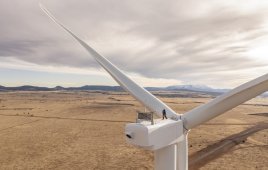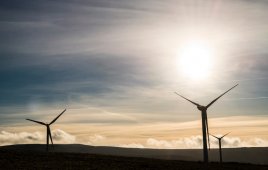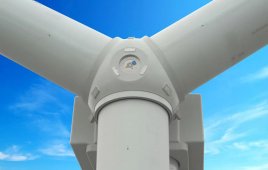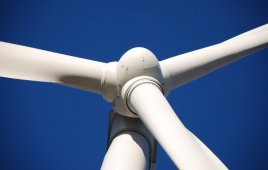Dr Sherif El-Henaoui Engineering Director Moog Inc. East Aurora, NY
Visit YouTube and type in the phrase “wind turbine explodes,” and you will see what could be fodder for an ad about the benefits of pitch-control systems. Beyond those who design and make these systems, the technology does not attract a lot of attention. But it should. A pitch-control system holds the key to maximizing and protecting a multimillion-dollar wind turbine. Pitch controls, mounted in the hub of a wind turbine, make it possible for a turbine operator to control the angle or pitch of a turbine’s blades. The European Wind Energy Association says pitch controls account for about 3% of a wind turbine’s price. But, like an insurance policy, a small investment makes a big difference when the weather turns from good to bad. As of 2007, analysts with Intercedent Asia estimated that 90% of new wind turbines included pitch controls. Although these are almost ubiquitous, knowledge about them is less so. When the wind hits 25 m/sec (50 mph) or higher, a wind turbine must put its blades at an angle that lowers their load and halts the wind turbine. Pitch controls that do the turning generally come in two forms: electric or hydraulic. Pitch control is not limited to failsafe situations. To set the turbine’s blades at an angle for best output, these systems will also adjust pitch (or turn) the blades a few degrees when the wind builds to roughly 12 to 13 m/sec (27 to 29 mph), which is when most turbines reaches peak performance.
The Danish Wind Industry Association recently wrote that “a pitch controlled wind turbine requires some clever engineering to make sure the rotor blades pitch exactly the amount required.” Most wind-turbine manufacturers (exceptions include Enercon and Vestas) tap others to make pitch control systems, so design subtleties may go undetected. For a buyer of wind turbines, it is important to know that most manufacturers are wedded to the use of either hydraulic or electric pitch control systems. Rarely do makers of wind turbines use both types. And, according to research from Intercedent Asia: “The [end users] choice of pitch-control system and design is wholly a function of their choice of manufacturer.”
Nobody would advise a buyer to choose a wind turbine primarily for the type of pitch control it includes. But understanding the differences between these systems will help a buyer’s overall purchasing decision.
Those familiar with pitch controls have varying points of view as to which system is superior and why. Electric pitch control has no risk of leaking hydraulic fluid. As a result, these systems pose no environmental issues, which can arise with a system relying on oil under high pressure. There is also lower consumption, or energy waste. Electric pitch controls tend to consume less power than hydraulic ones because the latter require a pump running at all times. That pump draws energy to keep the system’s oil at high pressure, as well as ready at a moment’s notice when rotor blades must be turned.
In electric pitch control systems, however, failsafe batteries or capacitors are a weakness. A pitch control battery lasts two to three years. When its life is over, it is an undertaking to replace it. Imagine scaling a 2MW turbine tower to swap out a battery in the hub of the prop.
“Supporters for hydraulic and electric systems always claim advantages for each type of technology,” said Peter Baldwin, a researcher with Intercedent Asia. “On the one hand, there’s a strong appeal for electric because of environmental issues. Another advantage to electric is that it’s better for colder climates because hydraulic oil lose viscosity as temperature plummets. But the speed and reliability of hydraulic systems is a clear strength.
 “Maintenance and diagnostics are said to be easier with hydraulics because fewer technical components are used,” adds Baldwin. “And, in spite of rising oil costs, the price of hydraulic fluid in pitch controls isn’t significant because it’s a closed system, recycling virtually all of the oil it needs.”
“Maintenance and diagnostics are said to be easier with hydraulics because fewer technical components are used,” adds Baldwin. “And, in spite of rising oil costs, the price of hydraulic fluid in pitch controls isn’t significant because it’s a closed system, recycling virtually all of the oil it needs.”
So which type of pitch control system is better? There is no clear winner, yet.
Developments on the horizon, however, may give wind-turbine manufacturers a third option: a hybrid control. With a hybrid control, the wind turbine’s blades are turned electrically while failsafe features, which prevent damage to the blades, runs hydraulically. Proponents of the hybrid design say the risk of leaking oil would be mitigated because the pitch control would rely mostly on electrical power. They contend that energy costs would be lower, too. And because a hybrid pitch control would rely on a hydraulic system for failsafe power, advocates point out that buyers wouldn’t have to worry about a failsafe battery losing charge in a few years.
Along with helping to efficiently produce power from the wind, the pitch controls – no matter what type – play a critical role in protecting and capitalizing on an investment in a wind turbine. Whether a design team selects electric, hydraulic, or hybrid, buyers owe it to themselves to understand this often overlooked system and use that know how when purchasing a wind turbine.
Dr Sherif El-Henaoui is the European marketing manager for Moog, Inc. He also manages activities for core industries, such as plastics machinery, and developing markets, such as wind energy and services.
This article was first published in NACE, Nov/Dec 2008, nacleanenergy.com
Filed Under: Components, Hydraulics, Turbines




